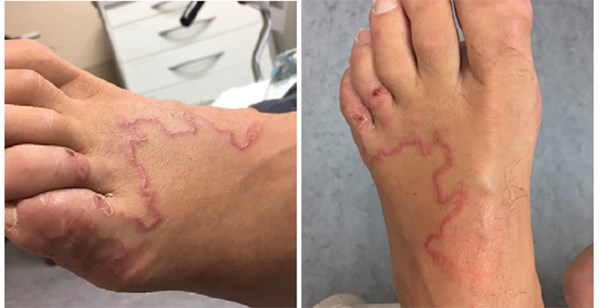What is the treatment for cutaneous larve migrans ?
CUTANEOUS LARVE MIGRANS [ CLM ] :
Cutaneous larva migrans (CLM) is a skin condition that’s caused by several species of parasite. You may also see it referred to as “creeping eruption” or “larva migrans.” Cutaneous larva migrans is a skin disease in humans, caused by the larvae of various nematode parasites the hookworm family. The parasites live in the intestines of dogs, cats, and wild animals; they should not be confused with other members of the hookworm family for which humans are definitive hosts.
CLM is typically seen in warm climates. In fact, it’s one of the most frequent skin conditions in people who’ve traveled to a tropical country.
WHAT ARE THE CAUSE OF CUTANEOUS LARVE MIGRANS ?
CLM can be caused by several different species of hookworm larvae. A larva is a juvenile form of the hookworm. These parasites are typically associated with animals such as cats and dogs.
The hookworms live inside the intestines of animals, which shed hookworm eggs in their feces. These eggs then hatch into larvae that can causean infection.
Infection can happen when your skin comes into contact with the larvae, typically in contaminated soil or sand. When contact is made, the larvae burrow into the upper layer of your skin.
People who are walking barefoot or sitting on the ground without a barrier such as a towel are at an increased risk.
CLM is most common in warm areas of the world. This includes regions such as:
- the southeastern United States
- the Caribbean
- Central and South America
- Africa
- Southeast Asia
The infection causes a red, intensely pruritic (itchy) eruption and may look like twirling lesions.The itching can become very painful and if scratched may allow a secondary bacterial infection to develop. Cutaneous larva migrans usually heals spontaneously over weeks to months and has been known to last as long as one year. However the severity of the symptoms usually causes those infected to seek medical treatment before spontaneous resolution occurs. After proper treatment, migration of the larvae within the skin is halted and relief of the associated itching can occur in less than 48 hours (reported for thiabendazole).
This is separate from the similar cutaneous larva currens which is caused byStrongyloides Larva currens is also a cause of migratory pruritic eruptions but is marked by 1) migratory speed on the order of inches per hour 2) perianal involvement due to autoinfection from stool and 3) a wide band of urticaria.
The signs of CLM typically appear 1 to 5 days after infection, although sometimes it takes longer. Common signs and symptoms include:
- Red, twisting lesions that grow. CLM presents as a red lesion that has a twisting, snake-like pattern. This is due to the movement of the larvae under your skin. Lesions can move up to 2 centimeters in a day.
- Itchiness and discomfort. CLM lesions may itch, sting, or be painful.
- Swelling. Swelling can also be present.
- Lesions on the feet and backside. CLM can occur anywhere on the body, although it most often occurs on areas likely to be exposed to contaminated soil or sand, such as the feet, buttocks, thighs, and hands.
Because CLM lesions can be intensely itchy, they’re often scratched. This can break the skin, increasing the risk for a secondary bacterial infection .
HOW TO TREAT CUTANEOUS LARVE MIGRANS ?
CLM is a self-limiting condition. The larvae under the skin typically die off after 5 to 6 weeks without treatment.However, in some cases it may take longer for the infection to go away. Use of topical or oral medications may help to clear the infection faster.
A medication called thiabendazole can be prescribed and applied topically to the lesions several times per day. Small studies have found that after 10 days of treatment, cure rates are as high as 98% .
If you have multiple lesions or a severe infection, you may need oral medications. Options include albendazole and ivermectin. Cure rates for these medications are close to 100% .
CUTANEOUS LARVE MIGRANS PREVENTION :
If you’re traveling to an area where CLM may be prevalent, there are a few steps that you can take to help prevent infection:
- Wear shoes. Many CLM infections occur on the feet, often from walking barefoot in contaminated areas.
- Consider your clothing. Other common areas for infection include the thighs and buttocks. Aim to wear clothing that covers these areas as well.
- Avoid sitting or lying down in potentially contaminated areas. This increases the area of skin that can be exposed to larvae.
- Use a barrier. If you’re going to be sitting or lying in an area that may be contaminated, putting a towel or fabric down may sometimes help prevent transmission.
- Look out for animals. If possible, avoid areas that are frequented by many animals, particularly dogs and cats. If you must travel through these areas, wear shoes.
- Consider the time of year. Some areas see spikes in CLM infections
during the rainy season. It may help to especially practice prevention during those times of the year.



Comments
Post a Comment